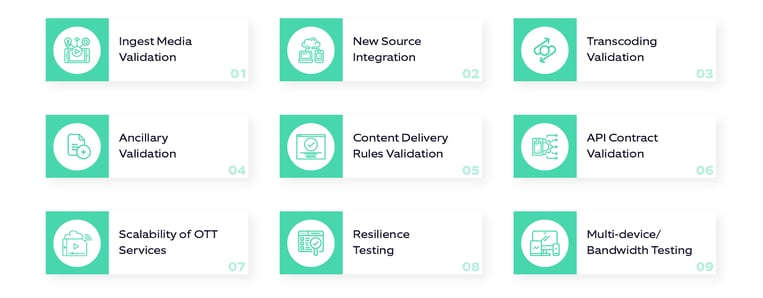On March 3 this year, Netflix’s web browser application stopped in the UK, Turkey, India (even though it still worked on the stand-alone app). ZEE5 crashed when logged-in users increased from 1.25 to 3 million within three hours.
These are just few examples of a streaming provider’s worst fears that can severely impact viewership and cost them memberships. According to a study, viewers tend to not play a video if it takes more than 2 seconds to load. A buffering delay (even as small as 1% of the video duration) reduces overall viewership by 5%. Can we meet user expectations? Let us find out!
Critical success factors for OTT
With the number of OTT platforms increasing continuously, consumers have a choice. To be successful in such a competitive landscape, OTT services must:
- Provide new and niche content.
- Ensure an engaging viewer experience.
- Offer subscription plans that cater to their audience.
Providing the latest content is rarely an issue and marketing can always provide various subscription plans based on analytics. The real differentiator is an engaging user experience.
How can issues like excessive buffering, bad audio quality, poor video resolution, and live stream crashes create a seamless and engaging user experience? OTT platforms must address these challenges through quality assurance to reduce the churn rate.
This blog will delve into the importance of quality assurance for OTT apps and discuss a QA strategy to provide an engaging user experience.
An effective quality assurance strategy
Once we have the OTT services in place, it is important to check operational costs, reduce additional development efforts, and ensure a quick turnaround for issue identification and resolution. The key to achieve all this is to have a good QA strategy. A holistic QA strategy considers all the intricacies of OTT services like:
- Multiple formats and multiple device support for end-to-end content delivery.
- Different network speeds of end-users and subsequent video quality.
- Digital rights management of the content.
- Security needs for managing subscription and access control.
- Integration with multiple systems to deliver content and related information.
- Performance testing aspects covering a sudden increase in demand and burst of viewers for a live show or a sport event.
- Viewer expectation and experience of content delivery.
- Testing the OTT platform across different browsers and platforms.
In addition to the above, we should also consider the importance of continuous and iterative testing as OTT services continue to evolve rapidly.
Testing through the media value chain of OTT services
The media value chain of OTT Services goes through different types of testing:

1. Ingest media validation
Content is ingested from multiple sources, depending on the business model of the video service provider. Each source provides content via microservices, web storage, or even FTP files. The ingestion module must ingest and manage the content continuously. Each source needs specific tools to check its content.
2. New source integration
When a new source is integrated into an OTT platform, it needs to be validated for format and specifications. This cycle is run whenever a new source is onboarded.
3. Transcoding validation
The ingested media is transcoded into multiple formats (HLS, DASH, CMAF) and resolutions (SD, HD, UHD, 4K, 8K). This process is normally done by the Just-In-Time (JIT) automated module. The automated validation for this module can make sure that the correct attributes are set for the content.
4. Ancillary validation
Each piece of content is coupled with multiple ancillary assets, like thumbnails, banner images, etc. The content contains related metadata which drives recommendation feeds and features such as X-ray. It is equally important to validate ancillaries, as much as the main content, to provide an engaging viewer experience.
5. Content delivery rules validation
Most OTT services deliver content based on predefined content delivery rules. These rules vary depending on business policies, subscription levels, geographical policies, device compatibilities, and UX optimizations. It is essential to validate all these rules and ensure that the content delivery follows defined guidelines.
6. API contract validation
APIs provided by diverse sources drive all OTT services. They are integrated with content provider APIs, search APIs, MRSS feeds for various platform partners, and many other sources. The OTT services are simply a combination of various Publishers and APIs. It is important to run a regular health check on API contracts to make sure that OTT services are running smoothly.
7. Scalability of OTT services
Since viewer experience is of utmost importance, routine load, security, and performance testing are a must. This ensures that the OTT platform is optimized and scalable enough to manage different high-stress situations.
8. Resilience testing
OTT services should manage load conditions and be resilient enough to manage chaotic traffic during a sudden surge of viewers. Resilience testing confirms that the OTT platform will perform well under stress.
9. Multi-device/bandwidth testing
Viewers typically use multiple devices, in varied bandwidth conditions, to access OTT apps. OTT services should provide a great video experience, as per device and bandwidth availability. A cross-device consistency check is essential to maintain a uniform user experience across devices.
In a nutshell
OTT services must have a well-planned approach to ensure thorough testing and use QA expertise. Most of the steps involved in a streaming platform are Just-In-Time, automated, and process a huge amount of data. It is recommended that you automate OTT service validation as much as possible. If this is planned and executed properly, it saves effort, increases efficiency, reduces the cost of quality, and improves viewer engagement.
With the ever-increasing demand for OTT, the proliferation of high-bandwidth networks, and device innovations, it is imperative to include testing as a key part of the OTT development strategy. At Nagarro, our PROVENTM testing methodologies can ensure maximum business value. To learn more, explore our offerings or connect with our experts.





